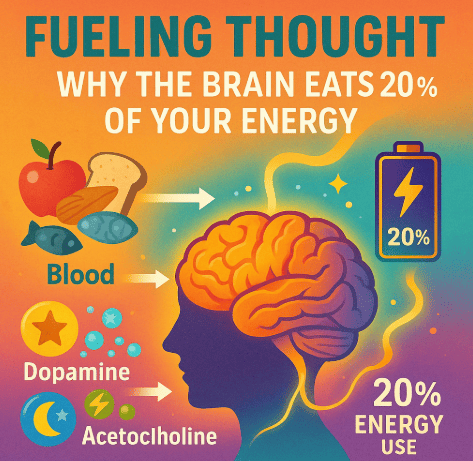
Quick Recap of Last Lesson
In Lesson 2, we learned that neurons talk to each other with neurotransmitters—chemical messengers that cross the synapse.
We saw how dopamine drives motivation, serotonin regulates mood, GABA calms, glutamate excites, and how drugs hijack these messengers.
But sending all these signals isn’t free. Each action potential, each neurotransmitter release, each recycling step costs energy.
The brain is not a “lazy organ”—it is an energy-hungry machine.
Now let’s uncover why.
Step 1: The Brain as an Energy Hog 🐷
Your brain weighs about 1.4 kilograms (roughly 2–3 pounds). That’s only about 2% of your total body weight.
But—here’s the shocking part—your brain uses about 20% of your body’s energy at rest.
👉 This means if you eat a sandwich, one-fifth of that sandwich is essentially powering your brain!
It’s like owning a phone that’s small but drains your battery faster than your TV, fridge, and washing machine combined.
Step 2: Where Does the Brain Get Its Energy? 🍬
The brain’s favorite fuel is glucose, a simple sugar that comes from the food we eat.
👉 Glucose = the basic sugar molecule your body uses for quick energy. It comes from bread, rice, fruits, pasta, potatoes—basically any carbohydrate.
Other body parts (like muscles) can burn fat for energy. But the brain almost never does. Fat burns too slowly. Neurons need fuel immediately, or they stop working.
That’s why if your blood sugar drops too low, you feel dizzy, confused, or even faint—the brain is running out of fuel.
Step 3: Neurons Are Energy-Intensive Machines 🔋
So why does the brain need so much energy? Three main reasons:
-
Maintaining the resting potential
-
Remember the -70 mV resting charge? Keeping sodium out and potassium in requires constant pumping.
-
The sodium-potassium pump (a molecular machine in the neuron’s membrane) pushes ions against their natural flow.
-
This pumping uses ATP (adenosine triphosphate), the energy “coin” of the cell.
-
👉 ATP is like a rechargeable battery molecule. Each time it breaks apart, it releases energy for the cell to use.
-
Firing action potentials
-
Every time a neuron fires, sodium rushes in and potassium rushes out. Resetting this balance costs energy.
-
A single neuron may fire hundreds of times per second. Multiply that by 86 billion neurons, and you see why energy demand is massive.
-
-
Releasing and recycling neurotransmitters
-
Packaging neurotransmitters in vesicles, releasing them, reabsorbing them, and breaking them down—all require energy.
-
So neurons are not passive—they are constantly “spending” ATP just to stay alive, even when you’re resting.
Step 4: Oxygen – The Brain’s Breath of Life 🌬️
Glucose alone isn’t enough. To convert glucose into usable energy (ATP), the brain also needs oxygen.
That’s why blood flow to the brain is so critical. If oxygen supply is cut off, neurons start dying within minutes. That’s what happens in a stroke, when a blood clot blocks oxygen delivery to part of the brain.
So every breath you take and every heartbeat you feel is partly to keep your brain’s lights on.
Step 5: Energy During Thinking vs. Rest 🤔😴
Here’s a surprising fact: your brain uses nearly the same amount of energy when you’re daydreaming as when you’re solving math problems.
This is because most energy isn’t spent on conscious thought but on “background” processes:
-
Maintaining ion balances
-
Replaying memories
-
Strengthening connections
-
Keeping circuits ready to fire
This background activity is called the default mode network—the brain’s “idle mode.”
So yes, thinking hard does use energy, but not as much extra as you’d expect. The brain is burning energy almost all the time, even when you’re not aware of it.
Step 6: Brain Energy in Special Cases ⚠️
-
During exercise – Muscles take up a lot of glucose, but the brain still insists on its steady supply.
-
During fasting – If glucose runs low, the brain can switch to ketones (molecules made from fat), but only partly. That’s why extreme fasting or starvation affects thinking.
-
During childhood – Children’s brains can use up to 50% of their body’s energy because they’re busy building connections. That’s one reason kids need lots of sleep and food!
-
During old age – Efficiency decreases, and diseases like Alzheimer’s can reduce how well the brain uses glucose.
Step 7: Why Brain Energy Matters 💡
Understanding brain energy helps explain many things:
-
Why breakfast matters – It refuels glucose after sleep.
-
Why fainting happens – The brain isn’t getting enough oxygen or sugar.
-
Why sugar crashes happen – A spike in blood sugar followed by a sharp drop confuses the brain.
-
Why kids need snacks – Their growing brains demand steady energy.
-
Why dementia is linked to metabolism – The brain’s “fuel system” breaks down.
So every bite you eat and every breath you take keeps your neurons firing.
Final Recap 📝
In this lesson, we discovered why the brain is such an energy hog. Though it’s only 2% of body weight, it uses 20% of energy, mostly from glucose.
Neurons spend energy to maintain their electrical charge, fire action potentials, and recycle neurotransmitters.
Oxygen is essential to turn glucose into ATP, the molecule that powers all cell work. Surprisingly, even at rest, the brain burns huge amounts of energy.
Children’s brains use even more, while aging brains often use less efficiently.